It’s not hard to set up a tropical fish tank. We already wrote about choosing the best tank and what you will need to get started. Don’t you feel excited? We do!
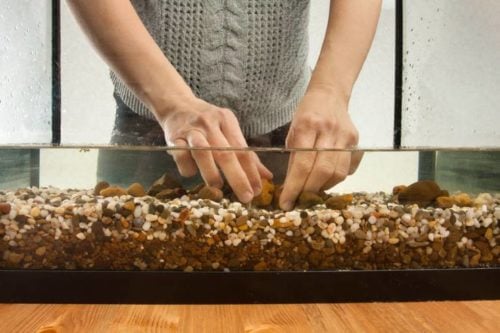
To recap, things that you need, the bare minimum to get started are: fish tank, gravel, decorations, filter, and heater. An air pump, airstone and hoses are optional, but you also need a bucket that you will use exclusively for aquarium. Do NOT buy any fish yet.
So, let’s set up your aquarium:
- Unpack your aquarium carefully as you do not want to scratch or break it. It’s a fragile object. Once done, rinse it thoroughly with water. You can use a sponge to wash its inside walls. Do not use detergents, however. It’s okay to use soap if needed, but you will have to rinse it properly.
- Place your aquarium on a stand or a piece of furniture in its permanent location.
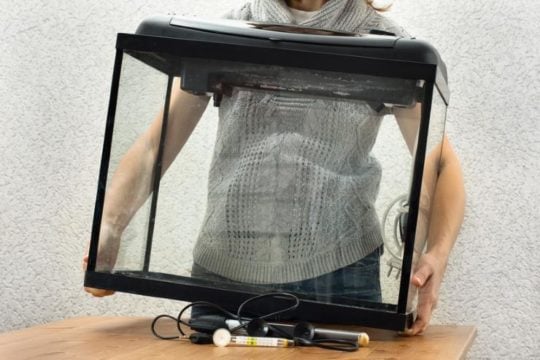 Make sure it is stable and can hold your fish tank filled with water. Remember, water is heavy. Make sure the stand is level, for which you can do with an instrument called level. If you don’t have it, you can fill in several inches of water in the tank and see if it is equally high on all corners. Even a minor slant means the pressure will be uneven on your fish tank’s walls, which asks for trouble. If the stand is not level, adjust screws on its legs, if there are any. Alternatively, place something, cardboard or linoleum pieces below them.
Make sure it is stable and can hold your fish tank filled with water. Remember, water is heavy. Make sure the stand is level, for which you can do with an instrument called level. If you don’t have it, you can fill in several inches of water in the tank and see if it is equally high on all corners. Even a minor slant means the pressure will be uneven on your fish tank’s walls, which asks for trouble. If the stand is not level, adjust screws on its legs, if there are any. Alternatively, place something, cardboard or linoleum pieces below them. - Rinse the gravel thoroughly. Place the gravel in a large bowl, fill it with the water and stir things up. You will see that the water gets muddy. Now pour the water in the sink, carefully not to pour out any pebbles, but quick enough, so the dust in the water gets washed away. Repeat this several times. In our experience, this step is long and usually requires at least ten repetitions. Don’t rush while there is no risk for fish if the gravel is dusty. The problem is that the dust will float up every time you change the water. Eventually, the filter will take care of it, though some time will have to pass.
- Put in the gravel. Setting up gravel is easy for artificial plants. You place whatever gravel you want (don’t pour it from above, you do not want to break the glass) and put decorations on top of them. If your aquarium contains live plants, you need to lay the gravel in layers. Below you have to put a finer-grained aquarium plant substrate. You can get it in pet stores where they sell aquariums. Upon it, you can place more coarse gravel or sand and finally end up with the top layer, which is gravel of your choice. Pet stores provide large variety, from natural-looking pebbles to bright colored gravel. Don’t dig up the sand or gravel somewhere, but them in a pet store. If you do, however, find something in nature, make sure to boil it for at least several minutes.
- Fill in the water up to about one third. A bucket with a lip is perfect for the purpose. A plastic bottle is also convenient for smaller aquariums. Since you do not have any fish in now, the water right from the tap is absolutely fine. Note, though, we assume that tap water is suitable for drinking, which it is in most western homes these days. If you know your tap water has quality issues, then you have to find a different source of water. Tip, if you pour the water rapidly, the stream can disrupt the gravel and decorations.
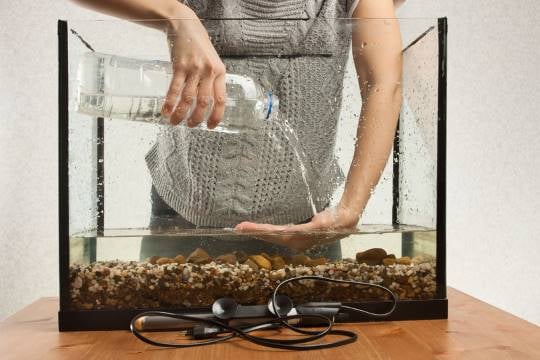 Quite often, books suggest placing a plate below the stream, so it spreads evenly. We find it inconvenient. When we fill up or replace aquarium water, we pour it in from the bucket while placing a palm below the stream. Wash your hands before, though.
Quite often, books suggest placing a plate below the stream, so it spreads evenly. We find it inconvenient. When we fill up or replace aquarium water, we pour it in from the bucket while placing a palm below the stream. Wash your hands before, though. - Set up the filter and heater. Read the instructions manual to do this. If you use an internal filter, which is a good choice for small to medium aquariums, attach it to the wall with suction cups, so the water outlet is close to the top. Hang the electricity cable outside. If you have an external filter, make sure you place water intake and outlet hoses according to instructions. For the heater, attach it to the wall and set the temperature in (learn more about aquarium water temperature here). Do not plug in any of these appliances, yet.
- If you plan to use an air pump, set up the airstone and attach the hose. You may use an airstone that you place on the gravel, attach to the wall, or that submerge inside the gravel. Air pumps are a beautiful addition, yet, not an absolute necessity if you use a good filter. Make sure the pump sits above the water level, or that there is a check valve installed in the line between the pump and an aquarium.
- Place in decorations. We will not give you advice on what decorations to put in. Options are many. Try to place larger decorations in the background and smaller ones in the foreground. Leave a place for plants, which again, taller ones in the back. Do not overlook decorations. If you will have a community fish tank, decoration helps smaller fish to hide and feel safer.
- Plant the plants. Regardless if you choose live or artificial plants, both types have to be “planted”. How to do it depends on the plants you get. Most plants will need to have roots inside the gravel. Dig a small hole, place the roots inside and cover it up.
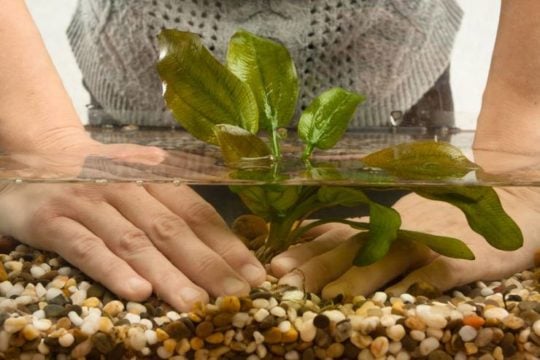 If your plants came in a small plastic container with rock-wool inside, remove this pot. Some sources will suggest you leave it, but no, it is not necessary.
If your plants came in a small plastic container with rock-wool inside, remove this pot. Some sources will suggest you leave it, but no, it is not necessary. - Fill the rest fish tank with the water. How much to fill up? Usually, a few centimeters (about an inch) from the top. It looks neat if you place the cover on, and you do not see the water surface. At this moment, you can double-check if your fish tank is level. If the water surface aligns with the top of the tank, you’re all set up. Put the cover on. Question: do you need to add something to the water? The market provides several fluids to add to water, to remove chlorine, reduce ammonia and to purify the water. Unless you have a large amount of chlorine added to your tap water, such treatment, in our opinion, is not necessary.
- Plug in the filter and heater. Both must have a marker for minimum water level. If you filled the water up to the top, there are no worries. If the tank is filled up only partially, make sure the water level is above these lines before turning them on. Make the cable of any appliance hang below the outlet and the loop back up to it. This way, any trip that gets on the cable will flow along with it and eventually will drop on the floor, not inside the outlet.
- Turn the lights on. Live plants need it and, even if you have artificial plants, we know you want to view your beautiful aquarium, right? We think there is no excuse not to set lights on a timer. You can buy an electricity timer in most hardware stores. You can plug them in a regular outlet, set up times it should be on, and the inside them you can plug any electrical appliance. This time, aquarium lights. We recommend starting with a 12 hours light/ dark cycle initially and then adjust it as needed.
- Do not add fish yet. Leve the fish tank running for several days before you add any fish. It is recommended to run it for a week but if you are anything like us, you won ‘t be able to hold back. So, what is the worst-case scenario if you let your fish in too early? Can they die? That is highly unlikely. The main reason why fish should not be let in, is to allow beneficial bacteria to build up in the filter and on the gravel. These bacteria turn waste-products of plant and fish metabolism into harmless substances. If you add in fish, the increase of waste products is steep, and you can experience either bacteria bloom or difficulty for the bacteria to grow. At the bare minimum, we recommend leaving an empty tank running for a few days. While you won’t correctly cycle the aquarium, you will make sure that everything is set up correctly and works fine.
- Add a small amount of fish. That is, you add larger fish (gourami, cichlids), add one initially.
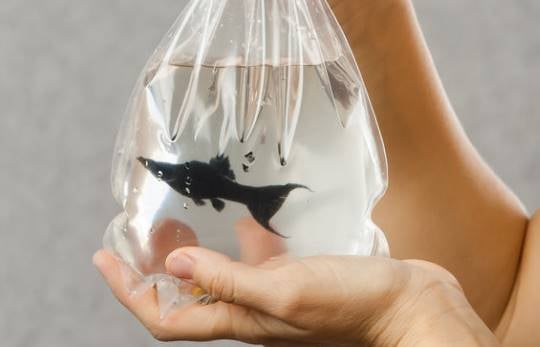 If you start with schooling fish (guppies, neons), add a small school, 4 to 6 individuals. The idea here again is to increase the load on aquarium filters gradually. Adding too much fish means there is a sudden increase in metabolic waste products, and bacteria that uses them for food can start to grow too rapidly.
If you start with schooling fish (guppies, neons), add a small school, 4 to 6 individuals. The idea here again is to increase the load on aquarium filters gradually. Adding too much fish means there is a sudden increase in metabolic waste products, and bacteria that uses them for food can start to grow too rapidly. - Add some more fish after several more days. Plan your aquarium carefully and best if you can add all the fish in several takes. It not only reduces the filtering load, as mentioned above, but also lessens the total amount of stress fish experience (yes, fish do have stress). Note that the amount of fish should not exceed the size of your aquarium. The rule of thumb is to have no more than 1 inch of fish per gallon of water (that’s 0.7 cm per liter). However, note that fish will grow up, so you need not measure your fish. Look up (google or ask at pets tore) how long they will grow. Another thing, the amount of fish does not directly depend on the volume of the tank, but the water surface. However, a more detailed explanation will follow in our next article.
So, there you go. It is not at all hard to set up a fish tank. Besides, regardless of the reason why you decided to own an aquarium, we are sure you will enjoy this process. If not, entrust fish tank set up to professionals.
